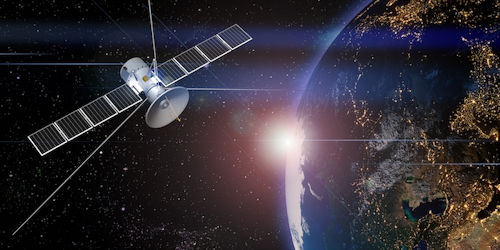Laser Focus: What Optical Components Are Used for Lasers?
15th Feb 2022As a specialist leading supplier of custom-made (and stock) high-precision optical components, Knight Optical’s customer base comprises a substantial directory of distinguished companies working on laser-based devices. The global optics provider investigates a few typical applications in this blog and explores recent pioneering projects that have made the news.

There’s a wide variety of different optical components that are used in laser applications. Of course, as the case is with all our projects, every design differs, and there’s no one-size-fits-all approach to specifying optics for this leading field of photonics. For instance, while some of our components are incorporated as a physical element of a system, others are utilised as a part of a separate arrangement to manipulate a laser beam.
Take our Laser Lenses, for example, which are designed to homogenise, shape, or focus beams, our Laser Mirrors, which are used for beam steering purposes or our Laser Filters that reflect or transmit specific quantities of laser light. Alternatively, a prime example of integrated optical components is Laser Windows, which are used to transmit light while protecting internal components as an active part of a system.
Our work with laser manufacturers spans three decades. Throughout this time, we have emulated the rapid growth of laser technology by heavily investing in the development of our very own premium-quality optics to exceed the judicious needs of our customers’ applications.
Typical applications for our optical components include:
- Laser scanning
- Laser ranging
- Spectroscopy
- Microscopy
- Laser guidance
- Target finding
- Laser sights
- Cosmetic surgery
- Laser cutting
- Laser welding
- Laser engraving.

Optics for Mass Production, Prototyping or One-Off Projects
As well as mass-produced optics for laser systems such as those mentioned above, we also provide bespoke, one-off components for prototyping, large-scale individual designs, and newfound technologies. These categories of projects range from the medical and biosciences sectors to the military and defence and entertainment industries, for instance.
Thanks to our commitment to refining our optical components, our ability to stay abreast of brand-new inventions and our flexibility when it comes to the manufacturing technicalities behind complex optical specifications, we’ve worked on some of the most game-changing systems of our time. Of course, many of our projects are NDA protected, and discretion is of the utmost importance here at Knight Optical. Therefore, below we’re highlighting some of the most recent laser technologies that are somewhat analogous to a few of the notable schemes that we’ve been a part of and bring some recent innovations into focus.
Lasers in the News…
…In Space
Laser technology is commonly used as a method of communication in space – known as free-space optical communication (FSO), which we’ve covered in greater detail in our previous blog on Optical Payloads. Of course, there are still many improvements to address regarding the challenges associated with communication in outer space. As such, things don’t always go to plan. Take, for instance, the General Atomics Laser Interconnect and Networking Communications System (otherwise known as LINCS). Launched in June last year for the Space Development Agency (SDA), LINCS – which carries optical communication terminals and infrared (IR) payloads – experienced some early challenges. Ultimately, General Atomics and SDA lost contact. However, more recently, the duo has been contemplating the project’s next steps.
Learn more about the project and General Atomics and SDA’s next move here: https://spacenews.com/space-development-agency-general-atomics-eye-options-after-setback-in-laser-comms-experiment/

And laser communication technology is indeed forecast to come on leaps and bounds in the coming years, particularly within the UK. At the end of January 2022, the UK Government announced a £1.4bn investment in cutting-edge technology as part of its first-ever ‘Defence Space Strategy’. According to the Government’s most recent release: “Over the next 10 years, £968m will be committed to delivering a multi-satellite system to support greater global surveillance and intelligence for military operations”.
Learn more about this investment here: https://www.gov.uk/government/news/uk-cutting-edge-space-defence-backed-by-14-billion
…In Battle
Our preceding news story transports us pleasantly onto our next sector, where not only working lasers are omnipresent, but enduring protection against these high-powered devices are also highly sought after, demonstrating the true diversity of optics both in built-in operation and as practical shielding components.
For instance, in early February 2022, optics.org reported that the UK’s military research facility, the Defence Science and Technology Laboratory (DSTL), is examining new materials to protect the optical sensors within the digital cameras that are used by its vehicle arsenal against attacks by lasers. Due to the sensitive nature of these sensors, they are easily damaged when subjected to powerful light sources, such as lasers. For this project, the Defence Science and Technology Laboratory (Dstl) has explored the potential of using protective filters to guard the sensors against high-intensity lasers.
Learn more about this story here: https://optics.org/news/13/2/12

Meanwhile, over the pond in the USA, the US Navy has recently released some information on its next-generation warship – named the DDG(X) ship – that will feature lasers that are 10 times more powerful “than any laser the service currently fields”. The US Navy has planned to attach two 600-kilowatt lasers, intended to disable guided missiles, to the ship’s rear and a 120-kilowatt laser towards the front.
Read more about this development here: https://www.dailymail.co.uk/news/article-10399533/US-Navy-unveils-plans-new-warship-fire-hypersonic-missiles-lasers.html
High-Performing Optics for High-Performing, Next-Generation Lasers
Considering widespread, ongoing advancements coupled with Government backing in the UK and system dependence within the US Navy, laser technology is undoubtedly set to further flourish. Here at Knight Optical, we’re highly anticipating this subsequent move, and we’re eager to play a key role in the expansion. So, if your laser project requires premium optical components, please do not hesitate to get in touch.
Why Choose Knight Optical for your Application?
Discerning customers rely on Knight Optical not only for the premium quality of our output and in-house state-of-the-art Metrology Laboratory and QA Department‘s capabilities but because – as well as a range of Stock Optics (available for next-day dispatch) – we also offer our optics as Custom-Made Components.
Last year, we celebrated 30 years in business. With over three decades’ experience under our belt and a whole host of long-standing world-renowned customers on our books, we are proud to have worked on some of the most revolutionary inventions.
If you are looking for premium-quality, bespoke optical components, please do not hesitate to get in touch with a member of the Technical Sales Team today.
Europe, UK, Asia & RoW:
+44 (0)1622 859444
USA & Canada:
+1 401-583-7846